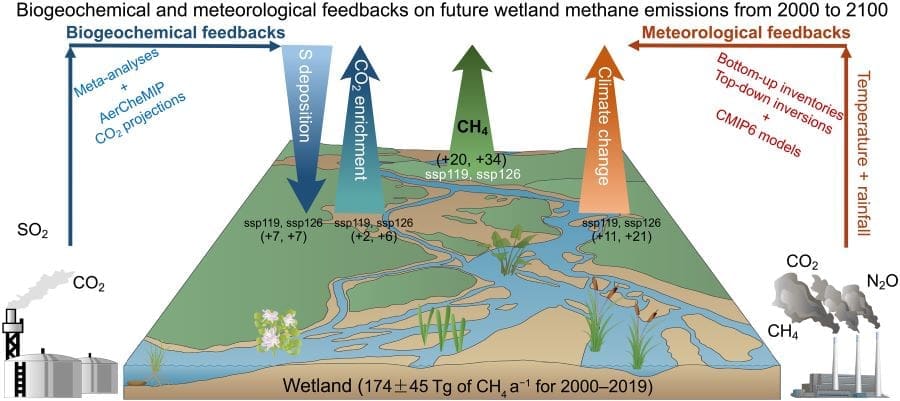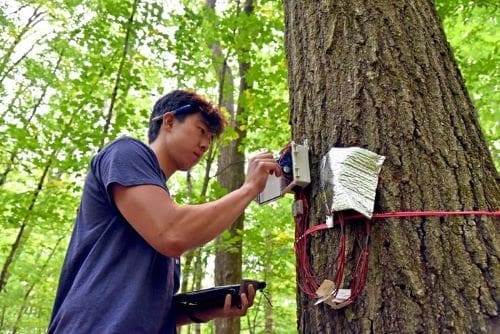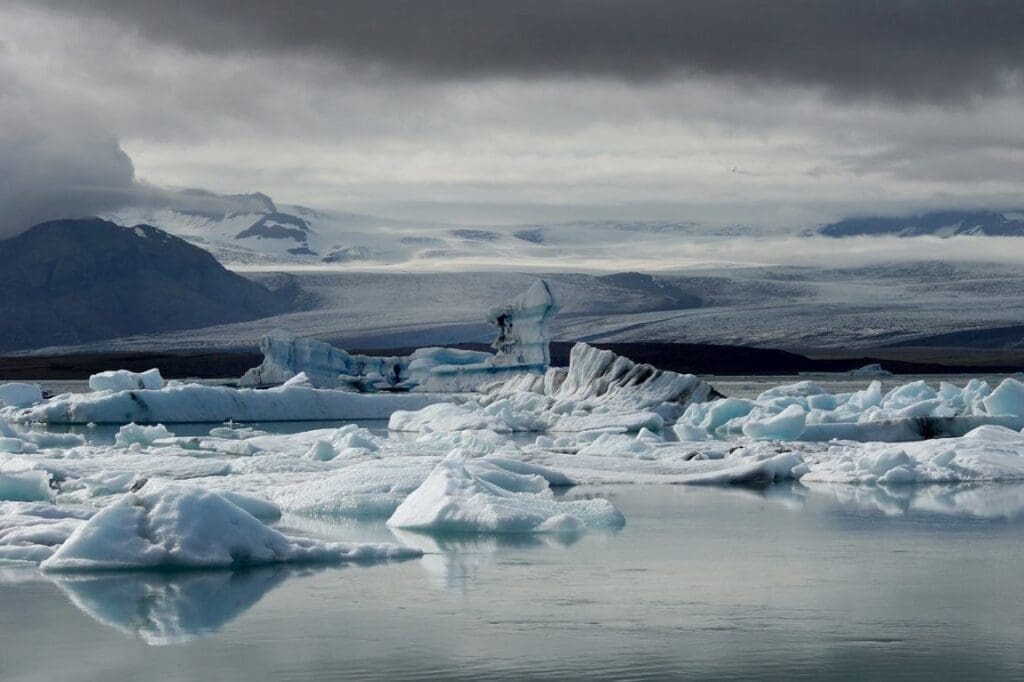Explore the latest insights from top science journals in the Muser Press daily roundup, featuring impactful research on climate change challenges.
In brief:
Clean air policies having unintended impact driving up wetland methane emissions
Reducing sulphur in the air may inadvertently increase natural emissions of methane from wetlands such as peatlands and swamps, a new study has found.
The findings published in the journal Science Advances suggests that the decline of global sulphur emissions as the result of clean air policies, coupled with the warming and fertilization effects of carbon dioxide emissions lifts a lid on wetland methane production resulting in increased emissions.
The resulting additional future release of 20-34 million tonnes of methane each year from natural wetlands would mean targets to reduce human-caused emissions need to be more stringent than currently set out in the Global Methane Pledge.

Methane, which is one of the most potent greenhouse gases in trapping heat in the atmosphere, is produced in wetlands around the world. Sulphur (in the form of sulphate) has a very specific effect in natural wetlands that reduces methane emissions, while CO2 increases methane production by increasing growth in plants that make the food for methane-producing microbes.
Professor Vincent Gauci from the University of Birmingham and a senior author of the study said:
“Well-meaning policies aimed at reducing atmospheric sulphur appear to be having the unintended consequence of lifting this sulphur ‘lid’ on wetland methane production. This coupled with increased CO2 means we have a double whammy effect that pushes emissions much higher.
“How has this happened? Put simply, sulphur provides the conditions for one set of bacteria to outmuscle another set of microbes that produce methane when they compete over the limited food available in wetlands. Under the conditions of acid rain sulphur pollution during the past century, this was enough to reduce wetland methane emissions by up to 8%.
“Now that clean air policies have been introduced, the unfortunate consequence of reducing sulphur deposition, which does have important and welcome effects for the world’s ecosystems, is that we will need to work much harder than we thought to stay within the safe climate limits set out in the Paris agreement.”
More than 150 nations signed up to the Global Methane Pledge at COP26 in Glasgow, which seeks to reduce human-caused emissions of methane by 30% on a 2020 baseline, by 2030.
The study is the latest to implicate reductions in atmospheric sulphur in driving warming at a faster rate than anticipated. In 2020 shipping pollution controls were introduced to reduce emissions of sulphur dioxide and fine particles that are harmful to human health. This reduction in atmospheric sulphur over the oceans has been implicated in larger warming that expected in what has come to be known as ‘termination shock’.
Lead author of the paper Lu Shen of Peking University said:
“Our study points to the complexity of the climate system. Representation of these complex biogeochemical interactions has not previously been well integrated into estimates of future methane emissions. We show that it is essential to consider these feedbacks to get a true understanding of the likely future of this important greenhouse gas.”
Journal Reference:
Lu Shen, Shushi Peng, Zhen Zhang, Chuan Tong, Jintai Lin, Yang Li, Huiru Zhong, Shuang Ma, Minghao Zhuang, Vincent Gauci, ‘The large role of declining atmospheric sulfate deposition and rising CO2 concentrations in stimulating future wetland CH4 emissions’, Science Advances 11 (6) (2025). DOI: 10.1126/sciadv.adn1056
Article Source:
Press Release/Material by University of Birmingham
Global social media engagement trends revealed for election year of 2024
An analysis of more than 4 million Facebook posts created by news outlets and political parties in 2024 highlights global social media engagement trends and political polarization during a year which included elections for many countries.
Giulio Pecile and colleagues at Sapienza University of Rome, Italy, present these findings in the open-access journal PLOS One on February 5, 2025.
Prior research has suggested that the tailored content presented on social media platforms may reinforce political polarization and influence voter behavior. In 2024, a substantial portion of the world’s population participated in elections, providing an opportunity to examine global-scale social media engagement during a major election year.

Pecile and colleagues analyzed how audiences engaged with content posted on Facebook by news agencies and political parties between September 2023 and May 2024. The dataset included audience reactions (for instance, likes, comments, or shares) as indicators of engagement for around 4.2 million Facebook posts made by 508 news agencies and 176,000 Facebook posts by 336 political parties, across a total of 31 countries that held elections in 2024.
To uncover audience engagement patterns, the researchers applied a method known as principal component analysis, which is commonly used to analyze large datasets.
Focusing on a broad selection of topics — such as education, sports, and climate change — the researchers found that engagement on different topics varied between countries, between news outlets versus political parties, and between right- versus left-leaning groups.
Most notably, engagement levels for certain topics differed according to political orientation. Right-leaning news outlets and political parties had more engagement on politics, religion, and migration, while left-leaning news and political groups had more engagement on education, health and technology. The researchers note, however, that this divide is not absolute and their data suggest common ground can be found for specific issues.
The researchers also note that this study, while underscoring polarization risks of social media, could also inform efforts to narrow political divides and develop evidence-based policies on broadly important topics — such as climate change, public health, and war—that may be more likely to succeed.
The authors add: “This study offers a global perspective on how political and news-related content resonates with audiences during an election year, and underscores the influence of social media on public opinion and its potential to both deepen echo chambers and foster constructive dialogue on critical global issues.
“Exploring the topics most covered and best received by political parties and news organizations, and analyzing the substantial difference between the reception of news and party content by users, can inform those groups on how to better connect to their public during the democratic process.”
Journal Reference:
Pecile G, Di Marco N, Cinelli M, Quattrociocchi W, ‘Mapping the global election landscape on social media in 2024’, PLoS ONE 20 (2): e0316271 (2025). DOI: 10.1371/journal.pone.0316271
Article Source:
Press Release/Material by PLOS
Plant power: A new method to model how plants move water globally
Earth systems models are an important tool for studying complex processes occurring around the planet, such as those in and between the atmosphere and biosphere, and they help researchers and policymakers better understand phenomena like climate change. Incorporating more data into these simulations can improve modeling accuracy; however, sometimes, this requires the arduous task of gathering millions of data points.
Researchers, including UConn Department of Natural Resources and the Environment Assistant Professor James Knighton, Pablo Sanchez-Martinez from the University of Edinburgh, and Leander Anderegg from the University of California Santa Barbara, have developed a method to bypass the need for gathering data for over 55,000 tree species to better account for how plants influence the flow of water around the planet.
Their findings are published in Nature Scientific Data.

Plants play essential roles in Earth’s processes, from capturing carbon and making oxygen available for other life forms like humans. Plants are also responsible for the movement of water, says Knighton, where an estimated 60% of all rain is returned to the atmosphere through transpiration.
This huge global-scale movement of water through plants is complex and currently represented by Earth system models (ESMs) in a simplified way says Knighton, where all plants in a region may be considered as a single entity (i.e., a plant functional type),
“Plant Functional Types (PFTs) are used because we don’t know a lot about the details of individual plant species,” says Knighton, a faculty member in the College of Agriculture, Health and Natural Sciences. “It would be harder to take a detailed map of vegetation over a continent and put in all the right values for each individual species so it’s easier just to consider one generic PFT.”
The problem with PFTs is that different plant species vary in their hydrologic traits – or how water moves through plants — and this oversimplification of such systemically influential traits could limit the effectiveness of available models to predict the future. Scientists have moved towards accounting for these differences by creating databases, like the TRY Plant Trait Database, where this information is collected. However, Knighton points out that only about 5,000 to 15,000 plant species have had their traits well-cataloged after several centuries of plant science.
“There are around 60,000 to 70,000 tree species on Earth, meaning that after 200 years, we know maybe 5 to 10% of what’s happening,” he says. “If that were the way we would do things, it would take us another 2,000 years or so to learn about all the plants that we needed to, and at that point, climate change has set in, and it’s too late. We can’t do that. We can’t just wait for field researchers to go out and do their studies and populate this global database. It’s still incredibly useful to conduct field studies, but those alone will not get us where we need to be fast enough.”
Knighton and his colleagues decided to address this problem and expedite the process by looking at the data for traits that are available, information like how tall a tree grows, how deep the roots descend, or how fast water flows within the plant. They then compared the history of that species and its relatedness to other species in what is called a phylogenetic test for those traits.

“We looked to see how similar trait values are between closely related species, and the idea behind that is, if these traits are critical for their survival, evolution will have preserved the trait values, they won’t be randomly dispersed,” Knighton says. “For example, if growing deep roots was critical for a certain type of plant to survive, the species that branch off from that one will probably also have deep roots, and everything that’s in that family or that genus will have a similar root structure.”
The researchers performed the test for all the traits, and Knighton says they found high levels of conservation across the phylogenetic tree, which means closely related species tend to have closer trait values.
“Then we took the phylogeny where you can take all of the plant species on Earth and map them onto each other, and show exactly how closely related each plant is to every other plant,” he says.
Knighton says they can impute the trait data if they have the information for closely related species, meaning that this data can be inferred without having to take millions of field measurements.
“We used different numerical machine learning techniques, and in doing that, we were able to come up with a database of these very critical tree values for 55,000 tree species on Earth,” he says. “If you want to do global modeling that includes more detail in the vegetation, which is important, you now have a starting point. You don’t have to use this generic, one plant species per continent approach, you could, in theory, try something more detailed, but putting in all the different species and seeing what happens.”
Knighton says they consider this work to be a low-order approximation, but it is an important starting point. As more data is collected from field researchers, the data can be used to update and refine the interpolated data to improve the accuracy of this approach.
This work is the next step in a larger project, the first step of which was a proof-of-concept experiment at a smaller, more local level. That project established this method of imputing hydrologic traits as a viable approach, and Knighton says the next step is to compare the imputed data with observational data that they are collecting in UConn Forest and from other sites around the United States.
Knighton explains there are 10 sites across the U.S. where ample data is collected, which will serve as test cases. Knighton says master’s student Caroline Stanton ’26 is currently building ecosystem models of each site, and they are calibrating high-resolution models to estimate the traits which they will compare with data that scientists have collected over the last 20 years. Then, they will compare the estimated plant trait results with the observational data collected from the site to see how the quality of the model is impacted by each approach.
Eventually, the researchers hope to apply the method to forested sites across the globe to study aspects of what drives traits to vary. Understanding the variation in traits across different plant species has the potential to strengthen the accuracy of models, but these data can also give insights into what drives the different traits to vary.
Knighton says he and his colleagues hope climate modelers will find this information helpful, but they also hope it can improve our understanding of the Earth system overall, and more about the vital roles plants play,
“Plants control our environment to an incredible degree.”
Journal Reference:
Knighton, J., Sanchez-Martinez, P. & Anderegg, L., ‘A global dataset of tree hydraulic and structural traits imputed from phylogenetic relationships’, Scientific Data 11, 1336 (2024). DOI: 10.1038/s41597-024-04254-4
Article Source:
Press Release/Material by Elaina Hancock | University of Connecticut
Cutting emissions in buildings and transport: Key strategies for 2050
Key findings: a roadmap to transform energy use by 2050
- Electrification (e.g., switching to electric vehicles, heat pumps) alone could cut direct emissions by 45-77% in buildings and 22-86% in transport by 2050.
- Combining electrification, efficiency improvements, and behavioral changes could reduce emissions even further: 51-85% for buildings and 37-91% for transport by 2050.
- A multi-strategy approach would lower overall electricity demand by 8-33% per year, making the transition more cost-effective and reducing strain on power grids.
- The findings align with global climate goals, showing that integrating these strategies can significantly contribute to limiting global warming to 1.5°C by 2050.

“These results demonstrate that the transition to clean energy in buildings and transport can be more manageable than previously thought,” explains Johannes Emmerling, Senior Scientist at CMCC. “By combining electrification with improved efficiency and smarter energy use, we can achieve dramatic emissions reductions while actually reducing strain on electricity systems — leading to lower costs and fewer infrastructure challenges as we tackle climate change.”
By focusing on how we heat our buildings and move around, the research provides a practical roadmap for addressing climate change. It shows that major emissions reductions are possible through three key strategies: electrification, which includes electric vehicles and heat pumps; improving energy efficiency through actions like better insulation and more efficient air conditioning systems; and altering how we use energy, such as by reducing dwelling sizes or adjusting thermostat settings.
Crucially, this work suggests that these key strategies can be implemented using existing technologies, like electric vehicles and energy-efficient building materials, without having to wait for future innovations.
Why this matters: a science and policy challenge
Unlike previous studies that examined individual measures in isolation, this research takes a comprehensive approach, using multiple Integrated Assessment Models to explore how different strategies interact, providing more robust and reliable results than previous single-model studies.
“Our study highlights the often-overlooked demand side of decarbonization,” says Alice Di Bella, PhD candidate and affiliated researcher at CMCC. “By comparing results from multiple models, we provide robust evidence that electrification, efficiency, and behavioral shifts are practical and effective solutions for climate mitigation.”
The study used seven global integrated assessment models, including the WITCH model developed at CMCC, to evaluate emissions reductions across different regions and policy scenarios. CMCC researchers played a key role in analyzing strategy interactions, emission scenarios, and cost evaluations, drawing on the center’s expertise in climate research and economic modeling.
Next steps: turning research into action
The study, published in Nature Energy, provides critical insights for policymakers, emphasizing that relying solely on electrification could create unnecessary burdens on electricity systems. Instead, a balanced mix of efficiency improvements, behavioral shifts, and electrification offers the most effective and economically viable path toward decarbonization.
“Our work highlights that the tools to cut emissions are already in our hands,” says Emmerling. “The main challenge lies not in technology but in policy and strategic implementation. By combining these strategies smartly, we can achieve significant reductions while making the transition more affordable, reducing strain on electricity grids, and ensuring a more sustainable future.”
Journal Reference:
van Heerden, R., Edelenbosch, O.Y., Daioglou, V. et al. ‘Demand-side strategies enable rapid and deep cuts in buildings and transport emissions to 2050’, Nature Energy (2025). DOI: 10.1038/s41560-025-01703-1
Article Source:
Press Release/Material by CMCC Foundation – Euro-Mediterranean Center on Climate Change
Featured image credit: Gerd Altmann | Pixabay




